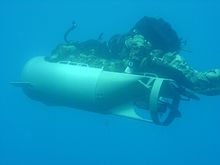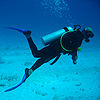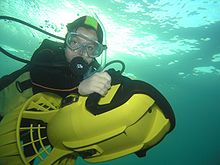- Diver propulsion vehicle
-
 Two U.S. Marines of the MSPF operating a Diver Propulsion Device (DPD) - Manufactured by STIDD Systems.
Two U.S. Marines of the MSPF operating a Diver Propulsion Device (DPD) - Manufactured by STIDD Systems.
A diver propulsion vehicle (DPV, also known as an underwater propulsion vehicle or underwater scooter) is an item of diving equipment used by scuba and rebreather divers to increase range underwater. Range is restricted by the amount of breathing gas that can be carried, the rate at which that breathing gas is consumed under exertion, and the time limits imposed by the dive tables to avoid decompression sickness. DPV's can have military application; an example is the Diver Propulsion Device (DPD) from STIDD Systems in the US.[1]
A DPV usually consists of a battery-powered electric motor, which drives a propeller. The design must ensure that: the propeller is caged so that it cannot harm the diver, diving equipment or marine life; the vehicle cannot be accidentally started or run away from the diver; and it remains neutrally buoyant under all conditions.
DPVs are useful for long journeys at constant depth where navigation is easy. Typical uses include cave diving and technical diving where the vehicles help move bulky equipment and make better use of the limited underwater time imposed by the decompression requirements of deep diving.
For many recreational divers DPVs are not useful. Buoyancy control is vital for diver safety: The DPV has the potential to make buoyancy control difficult and cause barotrauma if the diver ascends or descends under power. Visibility of less than 5 metres makes navigating a DPV difficult. Also, many forms of smaller marine life are very well camouflaged or hide well and are only seen by divers who move very slowly and are very vigilant.
Contents
Types
 Frogman with a Russian IDA71 rebreather, riding a Protei 5, carrying a Russian APS Underwater Assault Rifle.
Frogman with a Russian IDA71 rebreather, riding a Protei 5, carrying a Russian APS Underwater Assault Rifle.
Manta-boards
This is an unpowered piece of board (usually square) with two long ropes attached. It is towed by a surface boat. A diver holds onto it and keeps it submerged by holding it at the correct angle like an upside-down aerofoil. It is named after the manta ray fish.
Diver-tugs, tow-behind, scooters
The most common sort of DPV is where a diver is towed behind it holding onto one of its two handles on its stern or bow. These types of scooters are efficient because the divers ride in the slipstream of the scooter as opposed to a "ride-on-top" which must be ridden and increases drag, which affects scooter battery burn time. Even more efficient are the tow-behind scooters where the diver wears a harness and backplate or BC with a front crotch-strap D-ring and the scooter is clipped by a bolt snap and tow leash with proper length. This way the diver rides above the slipstream of the scooter while remaining horizontal, thereby minimizing the energy used to move water (bollard pull).
Manned torpedoes and similar
These are roughly torpedo-shaped or fish-shaped vehicles that one or more divers (often two) ride. Sometimes they sit astride it. Sometimes it has hollows in its top and the divers sit inside them. One well-known type is the manned torpedo or "chariot" which commando frogmen used in World War II. Similar vehicles have been made for work divers or sport divers; as these do not have a warhead, their bow tends to be pointed for better streamlining. One example is the Dolphin which was made on the Isle of Wight (UK) in the 1970s.
Subskimmers
A subskimmer is a sort of Rigid-hulled inflatable boat (RIB). It is equipped to inflate and deflate itself. When submerged it seals its motor and runs with battery-electric thrusters. Thus it transforms between a fast, light, surface boat and a submerged diver-rider. There are these makes:
- Subskimmer. This project was started in the 1970s by Submarine Products Ltd. of Hexham in Northumberland, England and passed through various hands. Its thrusters are on a rotatable cross-arm. "Subskimmer" is a tradename owned by Alphachamp.
- Infernus. Infernus is smaller than Subskimmer. They use the word "subskimmer" as a generic term.
Torpedo-shaped with handles near its front end
Some Farallon and Aquazepp scooters have this arrangement and have a raised arm at the rear to support the diver's crotch against the water current.
Miscellaneous
- The first commercially available DPV was the Aquazepp built by Josef Rupprecht in Munich. Aquazepps remain popular with cave and technical divers who appreciate the robust build quality and flexibility in customisation of the machines.[citation needed]
- There are DPVs where the diver is held on in some other way. One example is the Protei-5 Russian diver-rider where the diver is clamped on top of it; there is a similar Russian DPV called Proton.
- There is a DPV called Proteus made in New Zealand that is strapped onto the diver's cylinder.
Wet subs
As DPVs get bigger, they gradually merge into submarines. A wet sub can be classed as a small submarine where the pilot's seat is naturally flooded and they must wear diving gear. Covert military operations use swimmer delivery vehicles (SDVs) to deliver and retrieve operators into harbors and near-shore undetected. An example is the Multi-Role Combatant Craft (MRCC) produced by STIDD Systems in the US.[1]
See also
References
- ^ a b "STIDD Military Submersibles". http://www.stiddmil.com. Retrieved 21 September 2010.
Underwater diving Types: 
Specialities: Equipment: Diving suit · Scuba set · Rebreather · Dive computer · Diver propulsion vehicle · Mask · Fins · Snorkel · Buoyancy control deviceDisciplines: Professional diving · Police diving · Military diving · Underwater photography · Underwater videographyHazards: Related: Categories:
Wikimedia Foundation. 2010.

